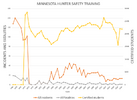I like charts that show interesting trends. Perusing the Minnesota DNR website and compiled some quick stats:
Before 1973 - Average firearm hunting fatalities were 8.7 annually
Since 1974 through 2022, after hunter safety courses were implemented, firearm hunting fatalities averaged 2.9 annually
Since 1974, hunting licenses sold has increased by over a factor of 3, while incidents and fatalities has remained low.

Also, perusing what incidents occurred, I found an interesting one. It's number 9 on the following link.
Always good to have a reminder. Remember dawgs, keep your paws off the trigger until you're ready to shoot.
Before 1973 - Average firearm hunting fatalities were 8.7 annually
Since 1974 through 2022, after hunter safety courses were implemented, firearm hunting fatalities averaged 2.9 annually
Since 1974, hunting licenses sold has increased by over a factor of 3, while incidents and fatalities has remained low.

Also, perusing what incidents occurred, I found an interesting one. It's number 9 on the following link.
Always good to have a reminder. Remember dawgs, keep your paws off the trigger until you're ready to shoot.
Last edited:



